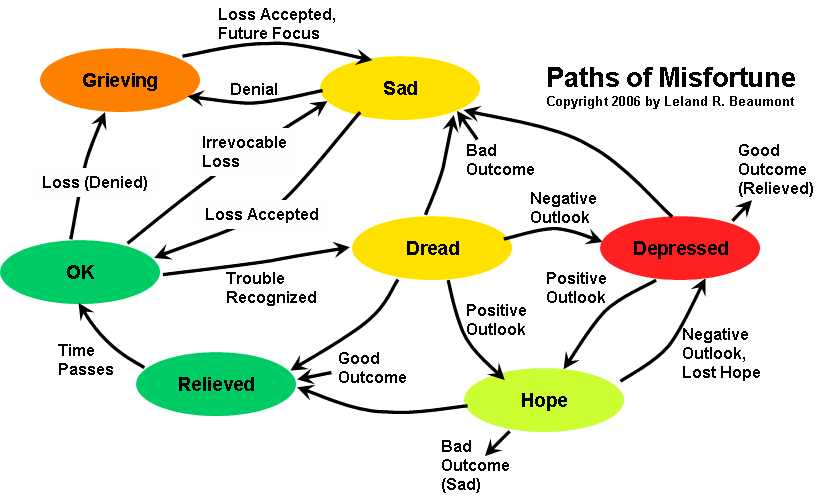Caution: Depression can be extremely dangerous. If you or someone you care about may be clinically depressed or is feeling depressed obtain competent professional help immediately.
Definitions
 Hopelessness, Hopelessness,- Loss of hope,
- Unspecific sadness,
- Despair,
- Loss of pleasure.
Root: depressen, to push down.
Depression is marked by anhedonia, also known as dysphoria, the inability to feel pleasure.
Sadness and Depression
Sadness is an emotion, it lasts for minutes, or hours or perhaps as long as a few days. Depression is a mood, it lasts for days, week, months, and sometimes years.
Symptoms
You feel awful, you are sad, unhappy, blue, downhearted, and discouraged. You may cry a lot and life is no longer fun. You may be anxious. You believe problems are your own fault, and you generalize your inadequacies. You are passive, indecisive, have trouble sleeping, and have lost your appetite. These symptoms are severe and prolonged, beyond the typical response to sadness.
Treating Depression
It is essential to get effective treatment of depression immediately. Treatment is well beyond the scope of this web site. Please consult a competent professional, perhaps from one of these resources:
Origins and Benefits
The origins and benefits of depression are not entirely known. It seems peculiar that such a debilitating condition would survive the rigors of evolution. However, there is a credible theory that deserves consideration. Pessimism is at the root of depression and pessimism acknowledges the realities of our difficult world. Several studies show that depressed people are more accurate in assessing reality that are non-depressed people. Optimism contributes to the aspirations that keep us going despite the many obstacles life entails. However, pessimism encourages us to face the harsh realities that require us to foresee obstacles, consider what can go wrong, plan for the worst, look skeptically at unrealistic optimism and wishful thinking, and keep our feet on the ground. Pessimism provides the dose of reality the dreamer needs to succeed.
Pessimism and Rumination
Some forms of depression follow from a pessimistic explanatory style. Losing hope, and seeing the future as bleak often result from believing personal, pervasive, and permanent causes explain failures. Rumination—repeatedly telling yourself you are the cause of these failures—makes a bad situation worse. You are constantly telling yourself you are to blame for the bad things in your life. Fortunately, help is available. You can dispute your own pessimistic thoughts and you may also be able to reduce your ruminating. Seek professional help if you are seriously depressed.
Paths of Depression
Several events that can trigger depression. How we respond to these losses and the choices we make affect our peace of mind, well being, and our lives. The following figure illustrates choices we have and paths we can take to either prolong or resolve our depression. Use this like you would any other map: 1) decide where you are now, 2) decide where you want to go, 3) choose the best path to get there, and 4) go down the chosen path.
You may wish to print out this one-page version of the Paths of Misfortune map

This diagram is an example of a type of chart known by systems analysts as a state transition diagram. Each colored elliptical bubble represents a state of being that represents the way you are now. The labels on the arrows represent actions or events and the arrows show paths into or out of each state. You are at one place on this chart for one particular interaction at any particular time. Other people are likely to be in other places on the chart. This is similar to an ordinary road map where you plot where you are now, while other people are at other places on the same map. Begin the analysis at the green “OK” bubble, or wherever else you believe you are now.
OK: This is the beginning or neutral state. It corresponds to someone who is feeling well. The green color represents safety, tranquility, equanimity, and growth potential.
Irrevocable loss: You recognize you have lost something valuable and that it is gone forever. You are sad.
Sad: You recognize an irrevocable loss. Perhaps you are crying or tearful. The yellow color represents the loss and pain.
Loss Accepted: When you can turn your thoughts to the future and leave the past behind, you have accepted the loss and can get on with your life.
Loss Denied: Protesting, denying, bargaining, and reliving the past all serve to deny the loss. You are living in the past and not ready to accept the loss. Grieving will continue.
Grieving: Grieving is a struggle to prevent the loss. It is our way of coping with loss and it may involve anger, anxiety, anguish, hope, or guilt. Once the protest and denial is over and the loss is accepted as irrevocable, then grief can turn into sadness and be resolved. Our focus shifts from the past to the future during bereavement. The orange color represents the agony, pain, duration, turmoil, and loss of the grieving period.
Loss Accepted, Future focus: You have decided it is time to get over it, accept the loss, and get on with your life.
Trouble Recognized: You become aware that you can lose something you value. You are worried and dread the possible loss.
Dread: You feel bad because you understand you may lose something. Depending on what it is you stand to lose, you may feel anxiety, fear, anger, shame, guilt, envy, or jealousy. The yellow color represents the loss, anxiety, and uncertainty of the time.
Positive Outlook: Although you recognize a bad outcome is possible, you are optimistic, you predict a favorable outcome, and maintain hope.
Hope: You believe with all the depths of your being that things will get better. You have hope; and you are doing things to improve your future. You are fearing the worst but expecting the best. Hope is the antidote to the hopelessness of despair. The green color represents the positive outlook, while the yellow color represents the uncertainty and possible bad outcome.
Negative Outlook: You predict the worst, you are pessimistic, and you have lost hope. You become depressed.
Depression: You have lost hope, the future looks bleak, you are depressed and feel hopeless. The red color represents the prolonged pain of the depression.
Good Outcome: Regardless if you were dreading, hoping, or depressed, you were spared your worst fears and the actual outcome is good. You are relieved.
Relieved: The frustration has changed for the better, and you learn that what you dreaded will not happen, you feel relief. Everything is now much better, you relax and feel a sigh of relief. The green color represents the good outcome and buoyancy of the relief.
Time Passes: The sensation of relief is rather brief. Soon you are back to your ordinary self, looking toward the future.
Bad Outcome: Your fears have come true. Regardless if you were dreading, hoping, or depressed, the actual outcome is bad, and now you are sad.
Quotations
- “The opposite of play is not work, it is depression.” ~ Stuart Brown
References
[laz] Passion and Reason: Making Sense of Our Emotions, by Richard S. Lazarus, Bernice N. Lazarus
[Ekm] Emotions Revealed: Recognizing Faces and Feelings to Improve Communication and Emotional Life , by Paul Ekman , by Paul Ekman
[OCC] The Cognitive Structure of Emotions , by Andrew Ortony, Gerald L. Clore, Allan Collins , by Andrew Ortony, Gerald L. Clore, Allan Collins
[Gol] Destructive Emotions: A Scientific Dialogue with the Dalai Lama , by Daniel Goleman , by Daniel Goleman
Learned Optimism: How to Change Your Mind and Your Life , by Martin E. Seligman , by Martin E. Seligman
5-HTP: The Natural Way to Overcome Depression, Obesity, and Insomnia , by Michael Murray , by Michael Murray
|
 Hopelessness,
Hopelessness,